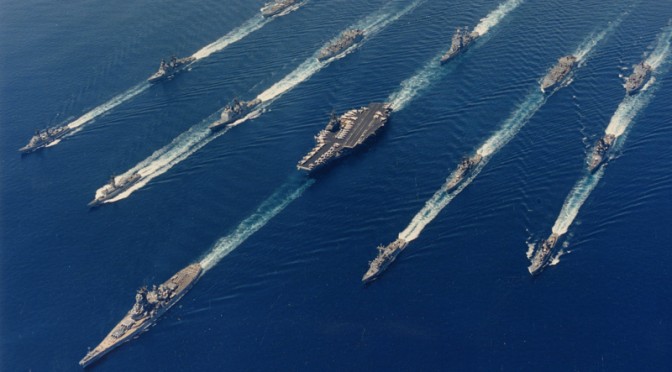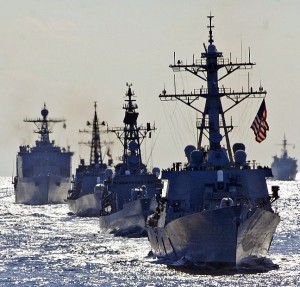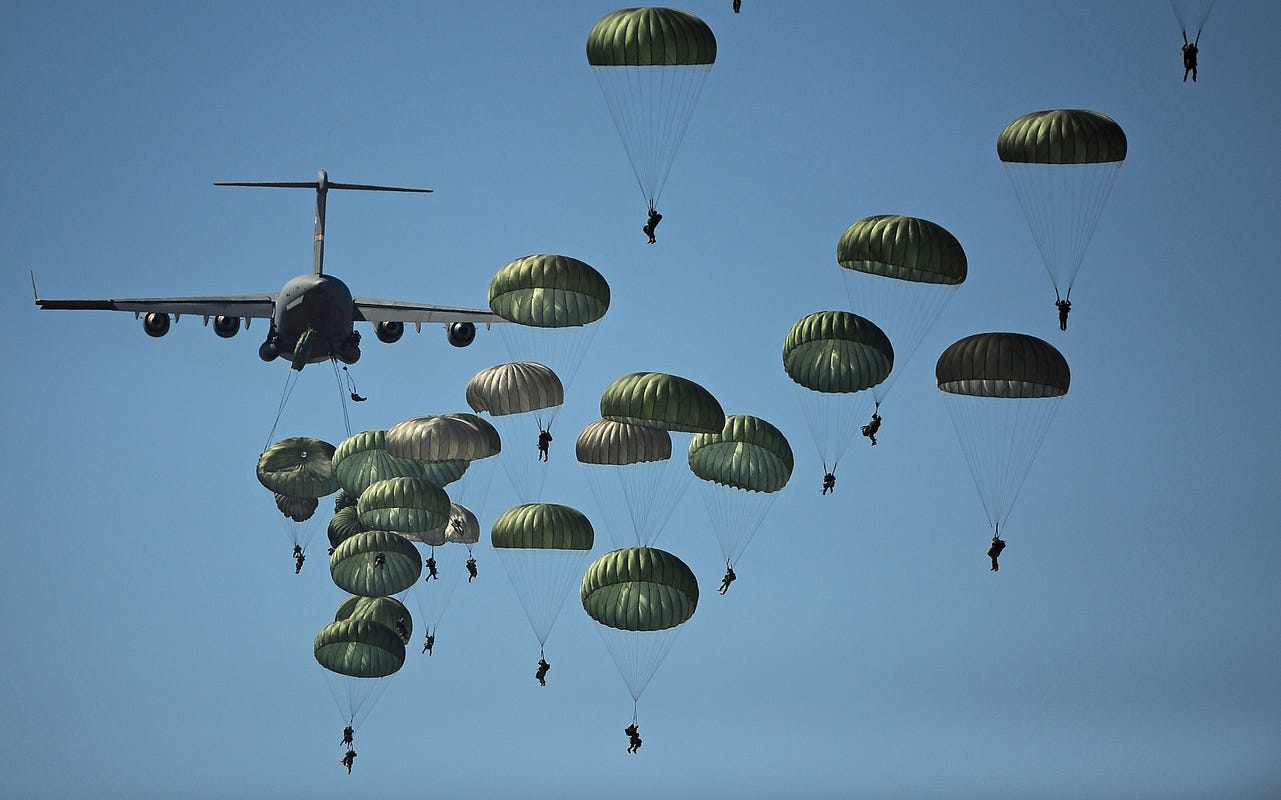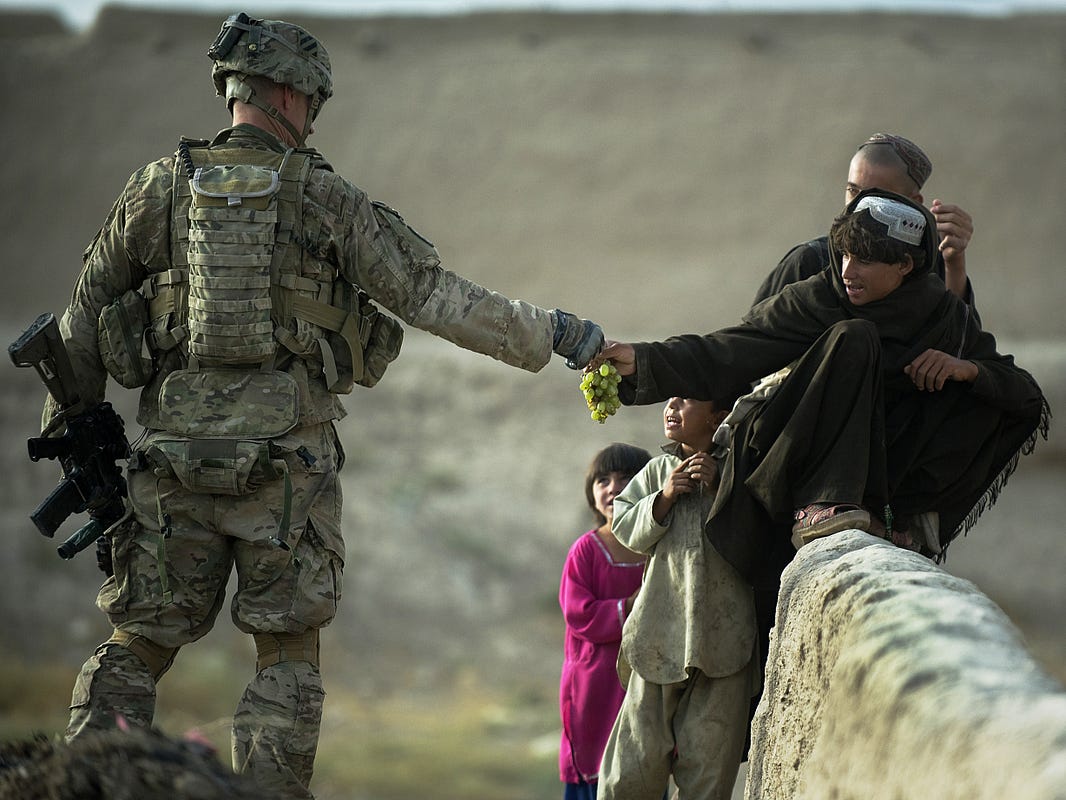CIMSEC is committed to keeping our content FREE FOREVER. Please consider donating to our annual campaign now so we can continue to provide free content.
By John T. Kuehn
Introduction
The ship of state that we call the United States is adrift at the political-strategic level or what some may call the grand strategic level. 24-hour news cycles, a president (and Congress) addicted to tweeting and posturing, an ambivalent and often ignorant public, and a complete failure by the national and sometimes international media to discern what is of value from what is pabulum has led to strategic gridlock in the foreign policy of the United States.
First, there are two caveats that must be addressed. The first caveat acknowledges that these ideas regarding a strategy for the United States of America are wholly unoriginal and derivative from those of Barry Posen, principally those in his article “Command of the Commons” (2002) and his book Restraint: A New Foundation for U.S. Grand Strategy (2014), and similarly focuses on concepts like grand strategy, command of the commons, and “liberal hegemony” (defined below).1 Secondly, ideas “on strategy” comes from Carl von Clausewitz’s On War. Book Three of that work addresses what we today call operational art more than it does grand strategy, but the elements of thinking about strategy at that level are not significantly different from thinking about it at the higher levels.2
On Strategy
A cursory structural examination of On War’s section “on strategy” reveals that when one turns to the index the first thing one reads is a list of topics, including a discussion of just what strategy is, or strategy as Clausewitz defines it. In today’s terminology Clausewitz expounds on campaign strategy, i.e. operational art at the operational level of warfare. Next, Clausewitz addresses some factors one does not normally associate with strategy writ large: virtue, moral factors, and things like boldness and “perseverance” (patience). Clausewitz is really discussing the attributes of the military strategist, although perhaps his comments can be extrapolated up the levels of war to the policy strategist in charge of overall events and national well-being or even survival. It closes, after a review of essentially Jominian operational considerations, on what might seem an odd pair of notes: “the character of contemporary war” and a discussion of “tension and rest.”3
These last two have particular importance for today because they get us from the operational level to what is normally now thought of as the strategic, or even grand strategic, level—the levels where ends are decided and acted upon. First the issue of tension and rest: “…in most campaigns, periods of inaction and repose have been much longer than periods of action.”4 This supports the claim made here that Clausewitz’s strategy here is really minor strategy, or campaign strategy. He is referring to the concept of culmination of action in war and that sooner or later exhaustion occurs at which point overt military activity (combat) diminishes or ceases while the protagonists build up combat power, will, political will, or all of the above to resume active operations. This has real implications for American policy today since the U.S. military has figured out how to keep the operational train moving with little suspension of action in places like Afghanistan, Iraq, and now Syria and Yemen. It has also figured out how, by using an all-volunteer force, unmanned aerial systems (i.e. “drones”), long range missiles (Tomahawks), and Special Forces to continue to get around this “dynamic law of war.” The naval aspect here is particularly important because U.S. naval forces have, since World War II, been primarily used for the purposes of power projection, not sea control or large scale fleet actions. This in turn has caused the application of naval power to be “a part of the problem” of maintaining the status quo of “permanent war for permanent peace.”
The U.S. military – and one must include CIA drone warfare and naval forces as mentioned above – keeps operations relatively constant, albeit at low levels, but still lethal. Interestingly, this steady state of activity does little to achieve long term political results and in Afghanistan in particular has led to what may be called a “declining status quo.” That is, a situation that over time gets worse. This is because the enemy – the Taliban, the Haqqani Network, Al Qaeda, and the Islamic State (ISIS)—all in Afghanistan, do not violate this law. They suspend operations and rest and then apply the tension at times and places of their choosing, slowly sapping the political will of their much more powerful, but ironically impotent, foes. They fight each other, too, but nonetheless they obey the law while “we” violate it. A similar dynamic is also witnessed in the ongoing conflicts in East Ukraine as well as the Syrian Civil War and a number of other conflicts around the globe in Asia and Africa.
Which brings us to Clausewitz’s second-to-last, and perhaps most compelling chapter in his book on operational strategy—which is what we can now properly characterize it as. He discusses the “character of contemporary warfare” in his day. The lesson here is not to draw lessons from Bonaparte’s 1812 Russian campaign, as he does in order to set up his law of “tension and rest,” but rather to tell the prospective operational artist or strategist that he or she, too, must assess the contemporary character of warfare as they craft a campaign strategy. He contrasts the nearly absolute wars of his day with those more limited wars of previous times: “Wars waged by both sides to the full extent of their national strength must be conducted on different principles from war in which policy was based on the comparative size of regular armies.”6 The lesson for today is that the character of contemporary wars must be assessed, on all sides – not just both sides since most wars these days have multiple protagonists, not a clearly delineated Axis versus Allies paradigm as in World War II.
The strategist must study contemporary warfare along with the other things Clausewitz says he must develop (patience and boldness) or study of the enemy (threats). This means understanding not just warfare locally, but one’s own cultural context for war. Perhaps the key character of contemporary American warfare — as opaque as it is to the majority of the American public — is that it is maintained by a political will unconnected to most Americans, in other words they are choices made by policy elites, choices most Americans either feel unable to affect or simply do not care about. This is dangerous. It cedes the initiative at the strategic level to the enemies we have chosen to engage with. Simply, policy elites have more skin in the game. It also increases the chance that the strategist will make choices disconnected from national interests and policies and more narrowly focused on the biases and preferences of the strategist himself. This also opens the door for irrational forces associated with emotions and neuroses of the strategist, rather than rational policy considerations, to influence decision-making. As Clausewitz emphasizes in his “fascinating trinity,” war is a team sport, not a solo event or just for a group of special insiders.7
Strategic Restraint
Here is where we bring in Barry Posen’s ideas about grand strategic restraint. First we must understand what he argues against. He does this by clearly outlining the existing grand strategy of the United States as something he calls liberal hegemony — and not a mild form either, but an aggressive, proactive form that emerged with the end of the Cold War. However, in the 1990s it was a more moderate form of what we have today. 9/11 caused a group of policy makers known as neoconservatives to adopt the more extreme elements of a liberal hegemonist agenda: muscular cooperative security and something Posen labels “military primacy.”8 Cooperative security was manifested, especially during the Clinton Administration, by the expansion and employment of NATO in the 1990s. Those who doubt this should consult Operations SHARP GUARD (Adriatic Sea 1993-1996), DELIBERATE FORCE (Bosnia 1995), and ALLIED FORCE (Kosovo 1999 ). More recently the implications of NATO’s expansion to include nations along the Baltic littoral have influenced how U.S. naval officers have had to think about meeting NATO obligations in that body of water with U.S. naval forces to continue the status quo of power projection. This has further stressed the capabilities of the U.S. Navy in ways that policy elites had not anticipated, nor adjusted force structure in the long term to address.
The NATO 1990s air campaigns highlight Posen’s second component—military primacy. But this primacy most forcefully manifested itself after 9/11. It was then demonstrated again with the invasion of Iraq in 2003 and the toppling of Saddam Hussein’s dictatorship. Even so, it had been conceived of years earlier, by President George H.W. Bush:
“Our first objective is to prevent the reemergence of a new rival, either on the territory of the former Soviet Union or elsewhere, that poses a threat on the order of that posed formerly by the Soviet Union. This is a dominant consideration…and requires that we endeavor to prevent any hostile power from dominating a region whose resources would, under consolidated control, be sufficient to generate global power.9
Liberal hegemony characterized by the maintenance of military primacy is the source of many of our problems vis-à-vis contemporary warfare. As long as this remains the policy of the United States, and there is nothing coming out of the current Trump administration to indicate otherwise, this is the United States’ strategy, like it or not.
So what is the way ahead? It all begins with persuasion. People made these decisions and people will make decisions that can ameliorate and perhaps get the United States to a position of relative “rest” in the current global system. Current moderation of strategy may be temporary and we could only be one crisis away in today’s 24-hour news cycle from another iteration of the more extreme approach in use since the end of the Cold War. Making restraint a habit takes time and practice.
Good News Bad News
A position that has merit is to return to the policy of Franklin D. Roosevelt (FDR) of the 1930s, armed neutrality with a build-up of naval and air forces to dominate the air and sea commons around the North American continent. Additionally, he was willing to make America serve as the “arsenal of democracy” to support those states who needed it against totalitarian and militaristic regimes.10 It was not his fault those states badly mismanaged the problem posed by the Axis causing FDR to more forcefully plan for war. Yes, FDR did not have to deal with intercontinental ballistic missiles, but during the Cold War the U.S. had some “good enough” strategies in place to manage this very scary scenario. But it is best managed by engagement with Russia, China, and even North Korea. Setting aside the nuclear case, let us return to the idea of “command of the commons” by primarily naval and air forces.11 That means efforts to better command, or influence, the space, air, ocean, and cyber commons. There is plenty to do in these domains, little of which requires “boots on the ground.”
However, liberal hegemony in its current state is looking more like “illiberal hegemony”—a reference of course to the rise of demagoguery and authoritarian personalities in traditionally democratic states. Said another way, U.S. grand strategy is on autopilot because of the current, self-induced presidential crises. Thus, the diplomatic-military-congressional-industrial complex continues doing what it was doing—maintaining liberal hegemony via primacy and cooperative security— and keeping its head down in Washington while servicing its agendas abroad.12 Meanwhile, policy elites bemoan a false change in U.S. strategy, claiming that restraint, or neutrality, or whatever one wishes to call it, has lost ground for the U.S. globally, first under President Obama and now accelerates with Donald Trump’s election.13 What has lost the U.S. ground globally is 16 years of indecisive and expensive military operations combined with an ongoing leadership crisis in Washington, not that leadership’s change of the current strategy. Posen himself has said as much in a recent interview.14
A metaphor will help explain the situation. The current “ship of state” for the U.S. is like an aircraft carrier that has lost the ability to control its steering from the bridge, and changing course from the bowels of the ship in auxiliary control (auxcon) has not occurred, thus the momentum of the current strategy continues to keep the ship on its last commanded heading — the failing and failed strategies of the past. There is no way to give orders to the helm to change the course of the ship of state on the bridge by the captain (president) — and no one has any idea how to regain control, some in fact prefer the rudderless ship.
Now for some good news — ironically, the ongoing loss of presidential power is a positive force for actually empowering changing the course from below.15 But there must be a will to change course “from below,” that is by the people executing (and making) policy in Congress as well as in the various executive bureaucracies. Donald Trump’s loss of power undermines effective execution of the strategy to some degree, but it does not change it. First we must admit that the overall strategy is misplaced. That is going to take some doing and it is not going to happen quickly. Thus, today’s strategists in America must get their heads out of the operational sands overseas, and turn their attention to the policy debates and battlefields back home.
Conclusion
Deploying three aircraft carrier groups into a sea-denial environment in the Sea of Japan—as was recently the case vis-à-vis North Korea—is not the best use of U.S. resources. Never, at any point in time has the leadership of the Navy been in a better position to drive strategy from below by dissenting on these meaningless, some might even call them reckless, displays of naval power. Admirals John Richardson (the CNO) and Admiral Harry Harris (PACOM) could set an example, and perhaps educate the civilian leadership (Jim Mattis and H.R. McMaster) in shepherding liberal hegemony by “just saying no.” They may be relieved in any case because of all the high profile Navy accidents, so why not make it count for something?16 Perhaps the Navy, and the nation, need another “revolt of the admirals,” as was seen in 1949 when the strategic ship of state was on the wrong heading.17 We do not need to create new frameworks and theories of strategy. We do need to think through the wisdom that is sitting already on our bookshelves and in the past. It is not too late to change course, if only we would. A good place to start is with naval forces. Someday, perhaps sooner than we think, this might no longer be true.
Dr. John T. Kuehn is a former naval aviator, retiring as a Commander from the U.S. Navy in 2004. He is professor of military history at the U.S. Army Command and General Staff College. Dr. Kuehn was awarded the Society of Military History Moncado Prize in 2010 and is the author of Agents of Innovation (2008) Eyewitness Pacific Theater (2008) with D.M. Giangreco, A Military History of Japan (2014), and Napoleonic Warfare (2015). His latest book is America’s First General Staff.
The views are those of the author and do not reflect the official policy or position of the Department of the Army, Department of Defense, or the U.S. Government.
References
[1] Barry R. Posen, Restraint: A New Foundation for U.S. Grand Strategy (Ithaca, NY: Cornell University Press, 2014), xii; see also Posen, “Command of the C)ommons, The Military Foundation of U.S. Hegemony,” International Security, Vol. 28, No. 1 (Summer, 2003): 5-46.
[2] Carl von Clausewitz, On War, edited by Peter Paret and Michael Howard (Princeton, NJ: Princeton University Press, 1986), 175; see also Clausewitz, “Two letters on Strategy,” located at http://usacac.army.mil/cac2/cgsc/carl/download/csipubs/carlvonc.pdf (accessed 11 June 2017).
[3] Clausewitz, On War, vi, 177, 184, 186, 220-221.
[4] Clausewitz, 221.
[5] This discussion based on recent scholarship by the author on the organizational culture of the US Navy, soon to be published as a chapter on the Navy since 1941 in anthology edited by Peter Mansoor and Williamson Murray by Cambridge University Press; the permanent war for permanent peace reference comes from Michael Howard’s discussion of Immanuel Kant’s ideas on collective security in War and the Liberal Conscience (New Brunswick: Rutgers University Press, 1994), 25-26.
[6] Ibid., 220.
[7] Clausewitz, 89. “Fascinating” is a better translation, according to Christopher Bassford, than “paradoxical.” See Clausewitz Homepage, https://www.clausewitz.com/readings/Bassford/Trinity/TrinityTeachingNote.htm (accessed 10/02/2017).
[8] Posen, 6-7.
[9] Defense Policy Guidance of first Bush administration, cited in Posen, 8.
[10] See David Kaiser, No End Save Victory (New York: Basic Books, 2014), 25-30, 155. Kaiser also highlights how FDR’s “four freedoms” contributed, via the crucible of war, to the adoption of liberal hegemony (157), although he perhaps did not intend to do this.
[11] Posen, “Command of the Commons,” passim.
[12] Andrew Bacevich, Washington Rules: America’s Path to Permanent War (New York: Metropolitan Books, 2010), 32; Bacevich implies the Congressional component on page 228.
[13] See for example Ben Miller, “Will Trumpism increase the Danger of War in the International System?” at https://networks.h-net.org/node/28443/discussions/176888/policy-series-will-trumpism-increase-danger-war-international (accessed 14/06/2017); see also Kyle Haynes, https://networks.h-net.org/node/28443/reviews/183005/haynes-lieber-retreat-and-its-consequences-american-foreign-policy-and (accessed 14/06/2017).
[14] See, https://cimsec.org/barry-posen-draft/30281 (accessed 14/06/2017).
[15] See John T. Kuehn, “Problematic Presidencies” at Proceedings Today, https://blog.usni.org/posts/2017/08/18/problematic-presidencies-are-not-necessarily-a-bad-thing (accessed 10/03/2017).
[16] The reference here is to the USS McCain and USS Fitzgerald collisions, among others, “Previous Collisions Involving U.S. Navy Vessels,” by May Salam, 21 August 2017 in New York Times, see https://www.nytimes.com/2017/08/21/us/navy-collisions-history-mccain-fitzgerald.html (accessed 10/27/2017).
[17] The CNO Admiral Louis Denfield dissented from existing Administration strategy and policy and was relieved by the Secretary of Defense. See Jeffrey G. Barlow, Revolt of the Admirals (Washington, DC, 1994), p. 288; Love, History of the U.S. Navy, p. 379.
Featured Image: Secretary of Defense James Mattis meets with the Joint Chiefs of Staff at the Pentagon in Washington, D.C., Jan. 23, 2017. (DOD photo by Air Force Tech. Sgt. Brigitte N. Brantley)










